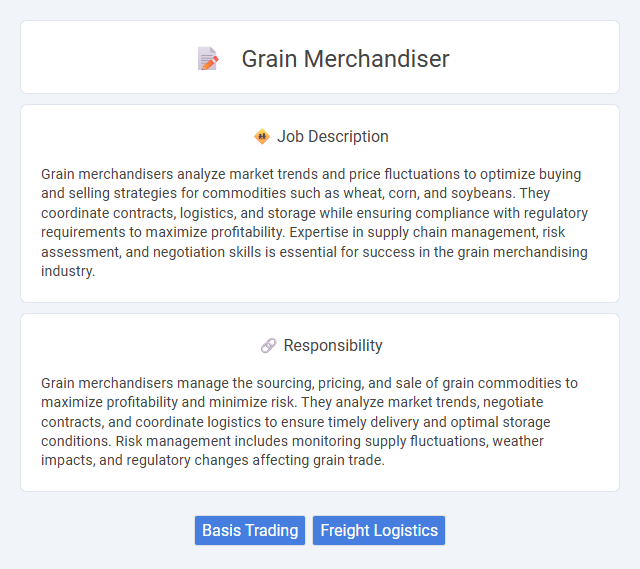
Grain merchandisers analyze market trends and price fluctuations to optimize buying and selling strategies for commodities such as wheat, corn, and soybeans. They coordinate contracts, logistics, and storage while ensuring compliance with regulatory requirements to maximize profitability. Expertise in supply chain management, risk assessment, and negotiation skills is essential for success in the grain merchandising industry.
People with strong analytical skills and a keen interest in market trends are likely to be well-suited for a grain merchandiser job. This role may suit individuals who can handle high-pressure situations and make quick decisions based on fluctuating commodity prices. Those who prefer structured environments with predictable routines might find the dynamic and fast-paced nature of grain merchandising challenging.
Qualification
A grain merchandiser requires a strong background in agricultural economics, agribusiness, or a related field, with proficiency in market analysis and commodity trading. Expertise in supply chain logistics, risk management, and price forecasting software is essential to optimize buying and selling strategies. Strong communication skills and experience with contracts and regulatory compliance ensure efficient negotiation and adherence to trade policies.
Responsibility
Grain merchandisers manage the sourcing, pricing, and sale of grain commodities to maximize profitability and minimize risk. They analyze market trends, negotiate contracts, and coordinate logistics to ensure timely delivery and optimal storage conditions. Risk management includes monitoring supply fluctuations, weather impacts, and regulatory changes affecting grain trade.
Benefit
Grain merchandiser roles likely offer substantial financial benefits through competitive salaries and performance-based bonuses tied to market fluctuations. There is a strong probability of gaining valuable industry experience that enhances career advancement opportunities within the agricultural sector. Benefits such as travel allowances and access to market data tools may also contribute to the overall compensation package.
Challenge
A grain merchandiser likely faces the challenge of navigating unpredictable market fluctuations and weather conditions that impact crop availability and pricing. Managing supply chain disruptions while meeting demand forecasts could pose a constant difficulty. Adapting quickly to changing trade policies and global economic factors may require strategic planning and risk assessment.
Career Advancement
Grain merchandisers play a crucial role in agricultural supply chains by analyzing market trends, negotiating contracts, and managing commodity transactions to maximize profitability. Advancing in this career typically involves gaining expertise in commodities trading, developing strong analytical skills, and building industry networks to move into senior trading or management roles. Professionals who excel may progress to positions such as senior merchandiser, commodities analyst, or trading desk manager, where strategic decision-making and leadership are key responsibilities.
Key Terms
Basis Trading
Grain merchandisers specializing in basis trading analyze local cash prices versus futures market prices to identify arbitrage opportunities and optimize profit margins in grain transactions. They monitor transportation costs, storage conditions, and supply-demand dynamics to effectively manage the basis spread and enhance trading strategies. Expertise in regional market fluctuations and timely execution of basis contracts is essential for maximizing returns and mitigating risks in grain merchandising.
Freight Logistics
Grain merchandisers specializing in freight logistics coordinate the transportation and delivery of bulk grain shipments to ensure timely and cost-effective distribution. They manage relationships with carriers, optimize shipping routes, and monitor freight contracts to minimize delays and reduce transportation expenses. Expertise in supply chain logistics and knowledge of port and rail operations are essential for efficient grain movement from harvest to end-market destinations.
 kuljobs.com
kuljobs.com